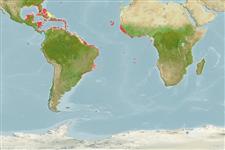Preferred temperature (Ref.
115969): 23.6 - 28.1, mean 27.4 (based on 940 cells).
Phylogenetic diversity index (Ref.
82804): PD
50 = 0.5005 [Uniqueness, from 0.5 = low to 2.0 = high].
Bayesian length-weight: a=0.00955 (0.00494 - 0.01846), b=3.09 (2.92 - 3.26), in cm Total Length, based on LWR estimates for this species & (Sub)family-body (Ref.
93245).
栄養段階 (Ref.
69278): 3.6 ±0.2 se; based on diet studies.
回復力 (Ref.
120179): 手段, 1.4年~4.4年の倍増期間の最小個体群 (Fec = 5,000).
Fishing Vulnerability (Ref.
59153): Low vulnerability (13 of 100).
